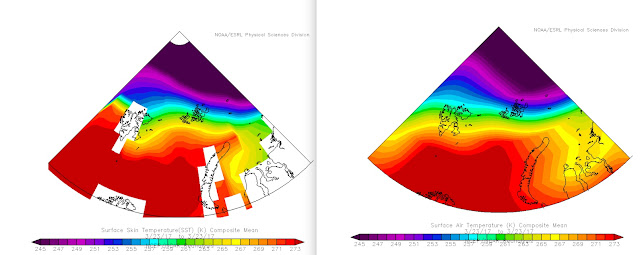~Ts>=Ttsi, Surface temperature is always greater or equal than top of sea ice temperature
~ Recommendation for buoy thermistors: measure in the shade
~ This rule is useful for calibrating remote sensing skin temperatures
~ Top of snow layer is coldest day or night, cloudy or sunny
One of the greatest features observed at the sea ice horizon is seen when the Astronomical Horizon is reached, this doesn't happen at any other time then when the air above it is isothermal. Above sea ice air can't be isothermal without downward solar flux equal or greater to the upward. This horizon altitude is only attained mainly in the Spring when solar radiation cancels the cooling done by top of sea ice deeply frozen over the long Polar winter. During the long Arctic Night, the Astronomical Horizon was never observed, the horizon always was above A.H...
Link here
http://eh2r.blogspot.ca/2015/05/dedicated-sea-ice-model-proofing.html
for the first formal hypothesis in May 2015, which included the first ever Sea Horizon Evolution sketch given the various seasonal temperature profiles:
Sea ice in green becomes dominant in winter, but only in spring can we observe the Astronomical
Horizon (in orange) coinciding with the horizon (in black horizontal line associated with the temperature profile). Prior to that, another very important feature dominates: top of sea ice is always colder than surface air. This gives a near permanent high horizon height, till the sun warms top of ice and in turn warms the air immediately above, then as the sun gradually rises higher day by day the horizon finally drops to A.H. But this higher than A.H. period needed data.
On one occasion I used Arctic sea ice buoys during the dark season to prove this optical rule in April 2016:
http://eh2r.blogspot.ca/2016/04/sea-ice-refraction-prime-rule-top-of_28.html
During the dark season, top of buoy thermistors were always colder than surface air.
Then we needed further in situ observations:
Nice sunny High Arctic day, in the snow drift shade atop a 1 meter high snow column density .36, the temperature of the top of snow was -32.3.
measured with a high precision Omega monitor attached to very sensitive Thermistor rated +-0.1 C.
A few meters away , the ventilated 2 meter surface temperature was -30.2 .
In the sun above or below snow , the thermistor warms rapidly to -29.3 in a few seconds.
Still outside , 1 minute later the thermistor keeps on warming to well above -27 C. The sun affects the thermistor greatly. Just like sea ice buoy thermistors embedded in snow.
Top of snow column being about 1 meter above ground, mid way down sideways, a shade reading is stable at -26.7 C. Like sea ice, the ground was warmer.
10 cm above ground the snow column is even warmer, again in the shade, -25.7 C. This is a sea ice proxy. The ground was warmer than the air....
After several days of data, it doesn't matter whether it is sunny or cloudy, day or night or whether the temperature trends warmer or colder, the temperature of top of snow column in the shade (or during evening) was always colder than the surface air. Thus proving the first rule of sea ice horizon refraction. I await warmer days.
And now for top of sea ice measurements:
Day after, March 21 2017, outside temperature was -28 to -29 C above sea ice with no 2 meter high ventilated surface reading, the picture above is snow over sea ice temperature measured within a snow drift shade, -30.2 C. By the ventilated screen, 3 kilometers away 46 meters ASL, outside temperature was -30 C with top of snow -34 C (in the shade). Sea ice surface here was about 40 cm below. Top of sea ice snow was 4 degrees warmer than top of land snow. This helps explain why the coldest Arctic air formations usually occur over land and or in the not so distant past, over very thick sea ice.
Right by thermistor in the sun. As warm as -26.8 C.
Direct vertical probing, -25.3 C in the shade, a few centimeters below the surface layer, sea ice snow was warmer than land snow.
Right by vertical probe hole, snow skin subdermal was -30.4 C, colder than surface air and the snow column just below it, there may be lateral light scattering affecting the deeper reading.
A small tide crack, 2 meters deep, sensor is about 30 cm from surface in open air, the temperature was -20.8 C. These openings are very common over the Arctic Ocean, the heat injection they give should be quite huge since there are hundreds of thousands such openings.
The first rule of sea ice horizon refraction is well confirmed by this model/ sat observations, basically suggests that NOAA/ESRL needs refining especially near coastal sea ice areas, this anomaly looks the same since last time I checked:
http://eh2r.blogspot.ca/2016/05/remote-sensing-vs-refraction-prime-sea.html
WD March 21-22 2017.

































